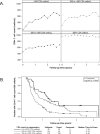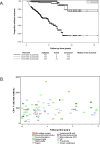Incomplete immune reconstitution despite virologic suppression in HIV-1 infected children and adolescents
- PMID: 25849832
- PMCID: PMC4391276
- DOI: 10.1097/QAD.0000000000000598
Incomplete immune reconstitution despite virologic suppression in HIV-1 infected children and adolescents
Abstract
Objectives: Some perinatally infected children do not regain normal CD4(+) T-cell counts despite suppression of HIV-1 plasma viremia by antiretroviral therapy (ART). The frequency, severity and significance of these discordant treatment responses remain unclear.
Design: We examined the persistence of CD4(+) lymphocytopenia despite virologic suppression in 933 children (≥ 5 years of age) in the USA, Latin America and the Caribbean.
Methods: CD4(+) T-cell trajectories were examined and Kaplan-Meier methods used to estimate median time to CD4(+) T-cell count at least 500 cells/μl.
Results: After 1 year of virologic suppression, most (99%) children achieved a CD4(+) T-cell count of at least 200 cells/μl, but CD4(+) T-cell counts remained below 500 cells/μl after 1 and 2 years of virologic suppression in 14 and 8% of children, respectively. Median times to first CD4(+) T-cell count at least 500 cells/μl were 1.29, 0.78 and 0.46 years for children with less than 200, 200-349 and 350-499 cells/μl at the start of virologic suppression. New AIDS-defining events occurred in nine children, including four in the first 6 months of virologic suppression. Other infectious and HIV-related diagnoses occurred more frequently and across a wide range of CD4(+) cell counts.
Conclusion: ART improved CD4(+) cell counts in most children, but the time to CD4(+) cell count of at least 500 cells was highly dependent upon baseline immunological status. Some children did not reach a CD4(+) T-cell count of 500 cells/μl despite 2 years of virologic suppression. AIDS-defining events occurred in 1% of the population, including children in whom virologic suppression and improved CD4(+) T-cell counts were achieved.
Figures


Similar articles
-
Immunologic function and virologic suppression among children with perinatally acquired HIV Infection on highly active antiretroviral therapy.Med Care. 2005 Sep;43(9 Suppl):III15-22. doi: 10.1097/01.mlr.0000175636.34524.b9. Med Care. 2005. PMID: 16116305 Clinical Trial.
-
CD4+ and viral load outcomes of antiretroviral therapy switch strategies after virologic failure of combination antiretroviral therapy in perinatally HIV-infected youth in the United States.AIDS. 2015 Oct 23;29(16):2109-19. doi: 10.1097/QAD.0000000000000809. AIDS. 2015. PMID: 26182197 Free PMC article.
-
Suboptimal immune recovery during antiretroviral therapy with sustained HIV suppression in sub-Saharan Africa.AIDS. 2018 May 15;32(8):1043-1051. doi: 10.1097/QAD.0000000000001801. AIDS. 2018. PMID: 29547445
-
Immunological recovery and antiretroviral therapy in HIV-1 infection.Lancet Infect Dis. 2006 May;6(5):280-7. doi: 10.1016/S1473-3099(06)70463-7. Lancet Infect Dis. 2006. PMID: 16631548 Review.
-
Emerging Role and Characterization of Immunometabolism: Relevance to HIV Pathogenesis, Serious Non-AIDS Events, and a Cure.J Immunol. 2016 Jun 1;196(11):4437-44. doi: 10.4049/jimmunol.1600120. J Immunol. 2016. PMID: 27207806 Free PMC article. Review.
Cited by
-
Getting to 90-90-90 in paediatric HIV: What is needed?J Int AIDS Soc. 2015 Dec 2;18(7Suppl 6):20770. doi: 10.7448/IAS.18.7.20770. eCollection 2015. J Int AIDS Soc. 2015. PMID: 28326130 Free PMC article. No abstract available.
-
Supranormal thymic output up to 2 decades after HIV-1 infection.AIDS. 2016 Mar 13;30(5):701-11. doi: 10.1097/QAD.0000000000001010. AIDS. 2016. PMID: 26730570 Free PMC article.
-
Global temporal changes in the proportion of children with advanced disease at the start of combination antiretroviral therapy in an era of changing criteria for treatment initiation.J Int AIDS Soc. 2018 Nov;21(11):e25200. doi: 10.1002/jia2.25200. J Int AIDS Soc. 2018. PMID: 30614622 Free PMC article.
-
Evolution of CD4 T-Cell Count With Age in a Cohort of Young People Growing Up With Perinatally Acquired Human Immunodeficiency Virus.Clin Infect Dis. 2024 Mar 20;78(3):690-701. doi: 10.1093/cid/ciad626. Clin Infect Dis. 2024. PMID: 37820036 Free PMC article.
-
Thirteen-year viral suppression and immunologic recovery of LPV/r-based regimens in pediatric HIV treatment: a multicenter cohort study in resource-constrained settings of China.Front Med (Lausanne). 2023 Dec 22;10:1313734. doi: 10.3389/fmed.2023.1313734. eCollection 2023. Front Med (Lausanne). 2023. PMID: 38188331 Free PMC article.
References
-
- Panel on Antiretroviral Guidelines for Adults and Adolescents. Guidelines for the use of antiretroviral agents in HIV-1-infected adults and adolescents. 2014 Available at aidsinfo.nih.gov/guidelines/html/1/adult-and-adolescent-treatment-guidel....
-
- Panel on Antiretroviral Therapy and Medical Management of HIV-Infected Children. Guidelines for the Use of Antiretroviral Agents in Pediatric HIV Infection. 2014 Available at aidsinfo.nih.gov/guidelines/html/2/pediatric-arv-guidelines. - PubMed
-
- Judd A, Doerholt K, Tookey PA, et al. Morbidity, mortality, and response to treatment by children in the United Kingdom and Ireland with perinatally acquired HIV infection during 1996–2006: planning for teenage and adult care. Clin Infect Dis. 2007;45:918–24. - PubMed
Publication types
MeSH terms
Substances
Grants and funding
LinkOut - more resources
Full Text Sources
Medical
Research Materials

